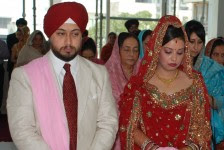Marriage, is not only a legal institution, the holiness of the union is indeed acknowledged in all the religions of the world. Sikhism, the youngest religion of our nation, is not different from the age old religions. Granth sahib (The holy book), lavan or phere (marriage hymns) and presence of saadh sangat (relatives and friends) remains central to the marriage ceremony.
Like most native marital traditions, Sikh marriage procedure begins by receiving and welcoming the groom and his relatives, who come to win and take the bride. The groom’s party has to come with a bang, and the “entry” is taken very seriously, the dhol rhythms announce the entry of groom and commencement of milnee. The parents, uncles, aunts, brothers and sisters of the bride and groom meet and greet each other. The ceremony of embraces also includes exchanging expensive gifts. Concluding with short treats of tea and snacks, the wedding party moves forward for the formal marriage ceremony. The vivid celebration is the best part of the ceremony, as this informal greeting (milnee) gives the chance of flaunting the expensive designer apparels!
The formal ceremony of marriage is called Anand Karaj; meaning a ‘blissful union’. The monogamous wedding is legalized by the couple’s honest consent to the ceremony of lavan. This ceremony involves a couple revolving four times around the granth sahib while the hymns are recited. The hymns are simple promises, the first lavan is the promise of fulfilling the love and duty towards the family and society, second lavan is the promise of love for each other, third and fourth are promise of detachment from the world and molding the love for each other into the love for the almighty. The most beautiful part of the laavan is the equality it gives to the man and woman, the promises are not gender based, but ask for simple social obligation a human has to do for society, spouse and lastly to the Lord. Thus often where obsolete traditions fail to voice a woman’s emotions, this ceremony leaves no wife out and makes her a bearer of marital bliss in same way as a man.
Witnesses are important for the conduction of the marriage; the granth sahib is the divine witness. While the family, relatives and local worshippers: or the saadh sangat are the important mortal witnesses. The bond is strictly monogamous with no place for divorce. However, the law of the land permits divorce for all the religions.
The ceremony is concluded with the customary singing of the six stanzas of the Anand Sahib (Song of Bliss), followed by Ardas (prayer) done for the well being of the couple, and Vak (a verse from Granth Sahib). This ceremony takes about an hour and ends with the serving of Karah Parshad to the congregation, and of course with a “Happily ever after”… from all the well wishers.
For more information you can reach us at -

No comments:
Post a Comment